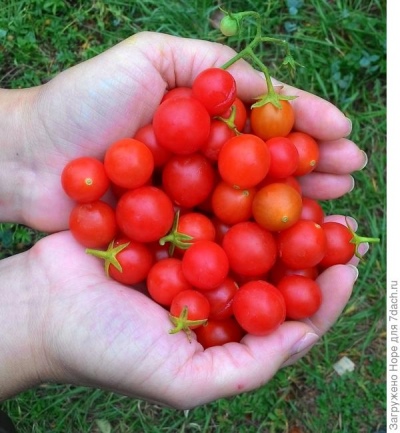
- Authors: M.I.Ogly Mamedov, V.G. Kachainik, M.N. Gulkin (Agrofirma "Aelita" LLC)
- Year of approval: 2001
- Category: grade
- Growth type: indeterminate
- Appointment: fresh consumption, for whole fruit preservation
- Ripening period: early
- Ripening time, days: 95-100
- Growing conditions: for film greenhouses
- Bush size: medium-sized
- Bush height, cm: 180-200
Along with the usual tomatoes grown annually by summer residents in the beds and in film shelters, you certainly want to grow some unusual variety that decorates the site and gives tasty fruits. For these purposes, cherry tomato Sweet million, which grows well in greenhouses, is suitable.
Breeding history
The early tomato Sweet million was created by a group of scientists from the Aelita agricultural firm (Kachainik, Gulkin, Ogly Mamedov) in 2000. A year later, in 2001, dessert tomatoes were entered into the State Register of Breeding Achievements of the Russian Federation and allowed for use. The variety has been zoned for all climatic regions of the country - the Far Eastern, Northern, Central, Middle Volga, West Siberian, Ural and Central Black Earth. The culture has shown itself to be the most productive, growing in greenhouse conditions.
Description of the variety
Dessert tomato Sweet million is an unusually beautiful bushy tree that grows compactly up to 180-200 cm. The medium-sized indeterminate bush is endowed with moderate foliage with green leaves, a strong central trunk, flexible branches, a developed rhizome and simple inflorescences. The first fruit cluster is formed above 8-9 leaves, where 18-20 miniature berries are tied.
Having made the decision to grow this tomato species, do not forget that it needs to be formed into 1-2 stems, regularly remove stepchildren, and also tie it to supports or trellises. In addition, it is recommended to cut off all the lower leaves and pinch the tops at the end of the growing season. Cherry tomatoes have a universal purpose, therefore they are widely used in cooking, pickled. The berries are ideal for canning whole fruits.
The main qualities of the fruit
Mini tomatoes represent a class of small-fruited nightshades. On average, a tomato is gaining 15-20 grams. When ripe, cherries have a uniform red color, and at the stage of ripening they are green with a dark speck at the base. The shape of the berries is ideal - rounded with a smooth surface. Tomato peel is smooth, shiny, not felt when eaten fresh or canned. The transportability of tomatoes is average, but keeping quality is long. Tomatoes may crack when overripe.
Taste characteristics
The tomato variety Sweet Million is famous not only for its visual appeal, but also for the excellent taste of the fruit. The pulp of the berries is of medium density, very juicy and aromatic. The taste is dominated by sweetness and sugariness.
Ripening and fruiting
Vegetable culture belongs to the early varieties. The first crop can be harvested 95-100 days after the mass germination of seedlings. Tomatoes ripen together, so you can remove them from the bush with whole fruit brushes. Yields peak in July-August.
Yield
High-yielding variety. If all the care recommendations are followed, the culture will certainly respond with a plentiful and stable harvest. On average, 4.8 to 7 kg of mini-tomatoes can be removed from 1 m2.
The timing of planting seedlings and planting in the ground
The culture is planted by the seedling method. Sowing of seeds is carried out in the first half of March. The seed is preliminarily sorted out, disinfected in a solution of potassium permanganate and treated with a growth stimulant.Germination is observed for 5-7 days, subject to the correct light and thermal conditions in the room.
Diving is carried out at the stage of 2-4 leaves on a bush. Sometimes during the cultivation of seedlings, it is required to dive twice. A week before being transplanted into the greenhouse, the seedlings are hardened, which will soften their adaptation to new growth conditions.
Bushes are planted at the age of 55-65 days, when 5-7 true leaves have already grown. Mid-May is considered a favorable period for transferring the bushes.

Growing tomato seedlings is an extremely important process, because it largely depends on whether the gardener can harvest at all. All aspects must be taken into account, from seedbed preparation to planting in the ground.
Landing scheme
The density and location of the bushes on the site is important, since they are determined individually for each tomato species. The recommended scheme for planting is 60x50 cm. 3 tomato bushes can be planted per 1 m2.

Growing and caring
The variety is not particularly picky about the soil, but it should be fertile, moist and breathable. Regarding care, it consists of standard measures: watering with warm water, feeding, loosening the soil, forming and tying a bush, removing stepchildren and excess leaves, ventilating the greenhouse, protecting against pests and fungi.




A plant needs different micronutrients at each stage of growth. All fertilizers can be divided into two groups: mineral and organic. Folk remedies are often used: iodine, yeast, bird droppings, eggshells.
It is important to observe the rate and period of feeding. This also applies to folk remedies and organic fertilizers.
Disease and pest resistance
Tomatoes are characterized by high immunity to many nightshade diseases - tobacco mosaic virus, apical and root rot, late blight. The plant is poorly protected from the invasion of insects, therefore, preventive spraying is necessary.


Resistant to adverse weather conditions
Due to their sufficient stress resistance, tomatoes can withstand temperature fluctuations, temporary shade and lack of moisture, as well as heat. Only drafts and excess moisture are undesirable for tomatoes, which can lead to disease.

























































































